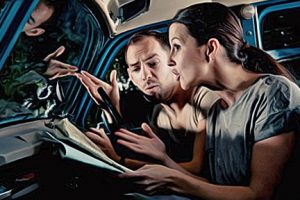 The ability to read maps is becoming something of a lost art. Personally, I have pretty limited skills in that area, but at least I have some idea of how it works, which is more than can be said for my niece and nephew. Aged 13 and 10, they’ve never actually witnessed anyone using a map for navigation, and are completely at a loss as to how it works. I’ve explained it repeatedly, and they’re just like, “…but how do you know where you are on the map?”
The ability to read maps is becoming something of a lost art. Personally, I have pretty limited skills in that area, but at least I have some idea of how it works, which is more than can be said for my niece and nephew. Aged 13 and 10, they’ve never actually witnessed anyone using a map for navigation, and are completely at a loss as to how it works. I’ve explained it repeatedly, and they’re just like, “…but how do you know where you are on the map?”
You don’t, kids. That’s the thing about maps – you never know for sure where you are on them. This makes sense because, in reality, you’re not on the map; you’re in a material landscape that you must navigate in a unique way, rather than with the power of logic alone. I understand the confusion, though. GPS gives the impression that, somehow, your being on a map is primary to your being in the world.
When I was a kid, my parents used paper maps to get us to our family holiday destinations. They didn’t have a GPS device until I was 18, and even then it was clunky thing that required manual updates and a fair bit of guesswork. I remember this one time when we were on holiday in Hobart. Automotive repairs being the order of the day, we were circling around the city in the cantankerous old van for a good 40 minutes before we realised that the service centre on the map had closed down two years prior.
The hotel, it seems, had found itself with a stack of slightly dated tourist maps, which it was duly palming off on unsuspecting out-of-towners. That would have been fine if it wasn’t for the busted car air conditioning. Hobart was in the middle of a rare heat wave at the time, and my parents were desperate to get the aircon back online before driving up to Launceston with four kids in town. Turns out we could have been halfway there by the time we found a service centre.
Sweet children of the post-millennium, you’ll never understand such things.